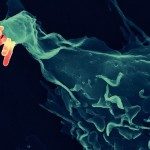Link to Pubmed [PMID] – 34283825
Link to DOI – 10.1371/journal.pbio.3001287
PLoS Biol 2021 Jul; 19(7): e3001287
The accumulation of α-synuclein (α-syn) aggregates in specific brain regions is a hallmark of synucleinopathies including Parkinson disease (PD). α-Syn aggregates propagate in a “prion-like” manner and can be transferred inside lysosomes to recipient cells through tunneling nanotubes (TNTs). However, how lysosomes participate in the spreading of α-syn aggregates is unclear. Here, by using super-resolution (SR) and electron microscopy (EM), we find that α-syn fibrils affect the morphology of lysosomes and impair their function in neuronal cells. In addition, we demonstrate that α-syn fibrils induce peripheral redistribution of lysosomes, likely mediated by transcription factor EB (TFEB), increasing the efficiency of α-syn fibrils’ transfer to neighboring cells. We also show that lysosomal membrane permeabilization (LMP) allows the seeding of soluble α-syn in cells that have taken up α-syn fibrils from the culture medium, and, more importantly, in healthy cells in coculture, following lysosome-mediated transfer of the fibrils. Moreover, we demonstrate that seeding occurs mainly at lysosomes in both donor and acceptor cells, after uptake of α-syn fibrils from the medium and following their transfer, respectively. Finally, by using a heterotypic coculture system, we determine the origin and nature of the lysosomes transferred between cells, and we show that donor cells bearing α-syn fibrils transfer damaged lysosomes to acceptor cells, while also receiving healthy lysosomes from them. These findings thus contribute to the elucidation of the mechanism by which α-syn fibrils spread through TNTs, while also revealing the crucial role of lysosomes, working as a Trojan horse for both seeding and propagation of disease pathology.





